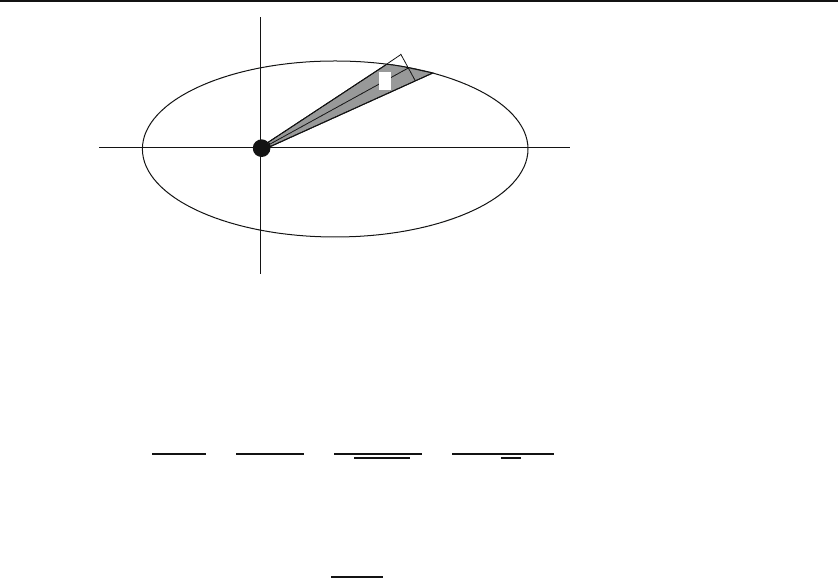Hassani S. Mathematical Methods: For Students of Physics and Related Fields
Подождите немного. Документ загружается.


576 Second-Order Linear Differential Equations
24.6.1 The Homogeneous Case
The solution to the HNOLDE
L[y] ≡ y
(n)
+ a
n−1
y
(n−1)
+ ···+ a
1
y
+ a
0
y = 0 (24.27)
can be found by making the exponential substitution y = e
λx
,whichresultsin
characteristic
polynomial of a
HNOLDE
the equation L[e
λx
]=(λ
n
+ a
n−1
λ
n−1
+ ···+ a
1
λ + a
0
)e
λx
= 0.This equation
will hold only if λ is a root of the characteristic polynomial
p(λ) ≡ λ
n
+ a
n−1
λ
n−1
+ ···+ a
1
λ + a
0
which, by the fundamental theorem of algebra, can be written as
p(λ)=(λ − λ
1
)
k
1
(λ − λ
2
)
k
2
...(λ − λ
m
)
k
m
. (24.28)
The λ
i
are the distinct roots of p(λ)withλ
j
having multiplicity k
j
.
It is convenient to introduce D ≡ d/dx and define the differential
operator
L = p(D)=D
n
+ a
n−1
D
n−1
+ ···+ a
1
D + a
0
.
Since D − μ and D − λ commute for arbitrary constants μ and λ,wecan
unambiguously factor out the above and obtain
L = p(D)=(D − λ
1
)
k
1
(D − λ
2
)
k
2
...(D − λ
m
)
k
m
. (24.29)
In preparation for finding the most general solution for Equation (24.27),
we first note that
(D − λ)e
λx
=
d
dx
e
λx
− λe
λx
= 0 (24.30)
and
(D − λ)(x
r
e
λx
)=
d
dx
(x
r
e
λx
) −λx
r
e
λx
= rx
r−1
e
λx
.
If we apply D −λ twice, we get
(D − λ)
2
(x
r
e
λx
)=(D − λ)(rx
r−1
e
λx
)=r(r − 1)x
r−2
e
λx
and in general,
(D − λ)
k
(x
r
e
λx
)=r(r − 1) ...(r −k +1)x
r−k
e
λx
which, for k = r,gives
(D −λ)
r
(x
r
e
λx
)=r!e
λx
.
If we apply D −λ one more time, we get zero by (24.30). Therefore,
(D −λ)
k
(x
r
e
λx
)=0 if k>r. (24.31)
The set of functions
{x
r
1
e
λ
1
x
}
k
1
−1
r
1
=0
, {x
r
2
e
λ
2
x
}
k
2
−1
r
2
=0
, ..., {x
r
m
e
λ
m
x
}
k
m
−1
r
m
=0
,

24.6 SOLDEs with Constant Coefficients 577
are all solutions of Equation (24.27). For example, an element of the first set
yields
L[x
r
1
e
λ
1
x
]=(D − λ
1
)
k
1
(D −λ
2
)
k
2
...(D −λ
m
)
k
m
(x
r
1
e
λ
1
x
)
=(D −λ
2
)
k
2
...(D − λ
m
)
k
m
(D − λ
1
)
k
1
(x
r
1
e
λ
1
x
)
=0 because k
1
>r
1
=0.
If the root λ is complex and the coefficients of the DE are real, then
the complex conjugate λ
∗
is also a root (see Problem 24.14). It follows that
whenever x
r
j
e
λ
j
x
is a solution of the DE for complex λ
j
,soisx
r
j
e
λ
∗
j
x
.Thus,
writing λ
j
= α
j
+ iβ
j
and using the linearity of L, we conclude that
x
r
j
e
α
j
x
cos β
j
x and x
r
j
e
α
j
x
sin β
j
x, where r
j
=0, 1,...,k
j
− 1,
are all solutions of (24.27).
It is easily proved that the functions x
r
j
e
λ
j
x
are linearly independent (see
Problem 24.13). Furthermore,
m
j=1
k
j
= n by Equation (24.28). Therefore,
the set
,
x
r
j
e
λ
j
x
-
, where r
j
=0, 1 ...,k
j
− 1andj =1, 2,...,m,
contains exactly n elements. We have thus shown that there are at least n
linearly independent solutions for the HNOLDE of Equation (24.27). In fact,
it can be shown that there are exactly n linearly independent solutions.
Box 24.6.1. Let λ
1
,λ
2
,...,λ
m
be the roots of the characteristic poly-
nomial of the real HNOLDE of Equation (24.27), and let the respective
roots have multiplicities k
1
,k
2
,...,k
m
. Then the functions x
r
j
e
λ
j
x
,where
r
j
=0, 1 ...,k
j
− 1, are a basis of solutions of Equation (24.27).
Example 24.6.1. An equation that is used in both mechanics and circuit theory is
d
2
y
dt
2
+ a
dy
dt
+ by =0 with a, b > 0. (24.32)
Its characteristic polynomial is p(λ)=λ
2
+ aλ + b which has the roots
λ
1
=
1
2
(−a +
a
2
− 4b)andλ
2
=
1
2
(−a −
a
2
− 4b).
We can distinguish three different possible motions depending on the relative sizes
of a and b.
(a) a
2
> 4b (overdamped): Here we have two distinct simple roots. The multi- overdamped
plicities are both one: k
1
= k
2
= 1 (see Box 24.6.1). Therefore, the power of t for
both solutions is zero (r
1
= r
2
=0). Letγ ≡
1
2
√
a
2
− 4b. Then the most general
solution is
y(t)=e
−at/2
(c
1
e
γt
+ c
2
e
−γt
).

578 Second-Order Linear Differential Equations
Since a>2γ, this solution starts at y = c
1
+ c
2
at t = 0 and continuously
decreases; so, as t →∞, y(t) → 0.
(b) a
2
=4b (critically damped): In this case we have one multiple root of ordercritically damped
2(k
1
= 2); therefore, the power of x can be zero or 1 (r
1
=0, 1). Thus, the general
solution is
y(t)=c
1
te
−at/2
+ c
0
e
−at/2
.
This solution starts at y(0) = c
0
at t = 0, reaches a maximum (or minimum) at
t =2/a − c
0
/c
1
, and subsequently approaches zero asymptotically (see Problem
24.23).
(c) a
2
< 4b (underdamped): Once more, we have two distinct simple roots. Theunderdamped
multiplicities are both one (k
1
= k
2
= 1); therefore, the power of x for both solutions
is zero (r
1
= r
2
=0). Letω ≡
1
2
√
4b − a
2
.Thenλ
1
= −a/2+iω and λ
2
= λ
∗
1
.The
roots are complex, and the most general solution is thus of the form
y(t)=e
−at/2
(c
1
cos ωt + c
2
sin ωt)=Ae
−at/2
cos(ωt + α).
The solution is a harmonic variation with a decaying amplitude A exp(−at/2). Note
that if a = 0, the amplitude does not decay. That is why a is called the damping
factor (or the damping constant). All three cases are shown in Figure 24.1.damping factor
These equations describe either a mechanical system oscillating (with no external
driving force) in a viscous (dissipative) fluid, or an electrical circuit consisting of a
resistance R, an inductance L, and a capacitance C. For mechanical oscillators,
a = β/m and b = k/m,whereβ is the dissipative constant related to the drag force
f
drag
and the velocity v by f
drag
= βv,andk is the spring constant (a measure of
the stiffness of the spring).
For RLC circuits, a = R/L and b =1/LC. Thus, the damping factor depends
on the relative magnitudes of R and L. On the other hand, the frequency
ω ≡
b −
a
2
2
=
1
LC
−
R
2
4L
2
depends on all three elements. In particular, for R ≥ 2
L/C, the circuit does not
oscillate.
Figure 24.1: The solid thin curve shows the behavior of an overdamped oscillator. The
critically damped case is the dashed curve, and the underdamped oscillator is the thick
curve.

24.6 SOLDEs with Constant Coefficients 579
24.6.2 Central Force Problem
One of the nicest applications of the theory of DEs, and the one that initiated central force
problem
the modern mathematical analysis, is the study of motion of a particle under
the influence of a central gravitational force. Surprisingly, such a motion can
be reduced to a one-dimensional problem, and eventually to a SOLDE with
constant coefficients as follows.
Subsection 12.2.1 treated the equations of motion of a particle under the
influence of a central force. Conservation of angular momentum and the right
choice of the initial position and velocity (what amounted to setting L =
L
z
ˆ
e
z
= L
ˆ
e
z
) eliminated the polar angle θ by assigning it the value π/2. Thus
the particle is confined to the plane perpendicular to the angular momentum
vector, i.e., essentially the vector r × v. The set of three complicated DEs
(12.20) reduces to a much simpler set consisting of (12.22) and (12.24) which
werewritehereas
m¨r −
L
2
mr
3
= F (r), ˙ϕ =
L
mr
2
. (24.33)
In principle, we can solve the first equation and find r as a function of t,
then substitute it in the second equation and integrate the result to find ϕ as
a function of time. However, it is more desirable to find r as a function of ϕ,
i.e., find the shape of the orbit of the moving particle.
In that spirit, we define a new dependent variable u =1/r, and making
multiple use of the chain rule, we write the DEs with u as the dependent
variable and ϕ as the independent variable. We thus have
r =
1
u
⇒ ˙r = −
˙u
u
2
= −
1
u
2
˙ϕ
du
dϕ
= −r
2
˙ϕ
du
dϕ
= −
L
m
du
dϕ
,
¨r = −
L
m
d
dt
du
dϕ
= −
L
m
d
2
u
dϕ
2
˙ϕ = −
L
m
d
2
u
dϕ
2
L
mr
2
= −
L
2
m
2
u
2
d
2
u
dϕ
2
.
Substituting for ¨r and r in terms of u and its derivative, Equation (24.33)
yields
d
2
u
dϕ
2
+ u = −
m
L
2
u
2
F
1
u
. (24.34)
Historical Notes
Johannes Kepler (1571–1630) was a premature baby and a very delicate child
who was brought up by his grandparents. After elementary and secondary schooling,
Kepler entered T¨ubingen University to become a Protestant minister. At T¨ubingen
Kepler was taught astronomy by one of the leading astronomers of the day, Michael
Maestlin (1550–1631). The astronomy of the curriculum was, of course, geocen-
tric astronomy. At the end of his first year Kepler got ’A’s for everything except
mathematics. Probably Maestlin was trying to tell him he could do better, because
Johannes Kepler
1571–1629
Kepler was in fact one of the select pupils to whom he chose to teach more ad-
vanced astronomy by introducing them to the new, heliocentric cosmological system

580 Second-Order Linear Differential Equations
of Copernicus. It was from Maestlin that Kepler learned that the preface to Coper-
nicus’s book, explaining that this was ’only mathematics’, was not by Copernicus.
Kepler seems to have accepted almost instantly that the Copernican system was
physically true, and from then on, astronomy and mathematics became his passion.
Kepler also worked and wrote a book in optics, in which he used the idea of a ‘ray
of light’ for the first time.
For the Kepler problem this equation is easy to solve because
5
Kepler problem
F (r)=−
K
r
2
⇒ F
1
u
= −Ku
2
and we have
d
2
u
dϕ
2
+ u =
Km
L
2
. (24.35)
Let v = u − Km/L
2
. Then Equation (24.35) becomes
d
2
v
dϕ
2
+ v =0.
The characteristic polynomial of this equation is λ
2
+ 1, whose roots are
λ = ±i. These simple roots give rise to the linearly independent solutions
v =sinϕ and v =cosϕ. The general solution can therefore be expressed
as v = C
1
cos ϕ + C
2
sin ϕ which, using Problem 24.22, can be rewritten as
v = A cos(ϕ −ϕ
0
). Therefore,
v = u −Km/L
2
= A cos(ϕ − ϕ
0
) ⇒ u = Km/L
2
+ A cos(ϕ −ϕ
0
)
or
equation of the
orbits in the
Kepler problem
r =
1
(Km/L
2
)+A cos(ϕ − ϕ
0
)
. (24.36)
This is the equation of a conic section in plane polar coordinates (see Problem
24.15).
We now investigate the details of Equation (24.36). First we note that
when ϕ = ϕ
0
, r is either a maximum or a minimum depending on the sign
of A. With an ellipse in mind, this corresponds to the (major) axis of the
ellipse making an angle ϕ
0
with the x-axis. Thus setting ϕ
0
= 0 corresponds
to choosing the axis of the conic section to be our x-axis. We adhere to this
choice and write
r =
1
(Km/L
2
)+A cos ϕ
. (24.37)
Next we want to determine the constant A in terms of the energy of the
particle. The potential energy (PE) is clearly −K/r. So, let us concentrate
5
Although the Kepler problem usually refers to the gravitational central force, we want
to keep the discussion general enough so that electrostatic force is also included. Thus, K
introduced below can be either GMm or −k
e
q
1
q
2
.

24.6 SOLDEs with Constant Coefficients 581
on the kinetic energy (KE). The velocity of the particle is given in Equation
(12.16) with θ = π/2and
˙
θ =0. Thus
KE =
1
2
mv
2
=
1
2
m(˙r
2
+ r
2
˙ϕ
2
)=
1
2
m ˙r
2
+
L
2
2mr
2
, (24.38)
where we used the second equation in (24.33). The second term in (24.38) is
sometimes called the centrifugal potential because (like a potential energy)
centrifugal
potential
it is a position-dependent energy that (like a centrifugal force) has resulted
from a velocity-dependent term. Differentiating Equation (24.37) with respect
to time gives
˙r =
A ˙ϕ sin ϕ
[(Km/L
2
)+A cos ϕ]
2
= Ar
2
˙ϕ sin ϕ.
Squaring and using the second equation in (24.33), we obtain
˙r
2
= A
2
r
4
˙ϕ
2
sin
2
ϕ =
L
2
m
2
A
2
sin
2
ϕ.
We can eliminate the sine term in favor of terms involving r by solving for
A cos ϕ in (24.37):
A cos ϕ =
1
r
−
Km
L
2
⇒ A
2
sin
2
ϕ = A
2
−
1
r
−
Km
L
2
2
.
It follows that
KE =
1
2
m
A
L
2
A
2
m
2
−
L
2
m
2
1
r
−
Km
L
2
2
B
+
L
2
2mr
2
=
L
2
A
2
2m
−
K
2
m
2L
2
+
K
r
and
E = KE + PE =
L
2
A
2
2m
−
K
2
m
2L
2
+
K
r
−
K
r
=
L
2
A
2
2m
−
K
2
m
2L
2
,
so that
A = ±
2mE
L
2
+
K
2
m
2
L
4
.
To avoid negative signs at later stages, we choose the negative sign now and
finally write
r =
L
2
/(Km)
1 −
2EL
2
/(K
2
m)+1 cosϕ
=
L
2
/(Km)
1 − e cos ϕ
, (24.39)
where
e ≡
2EL
2
K
2
m
+ 1 (24.40)
is called the eccentricity of the conic section.
eccentricity of
orbits

582 Second-Order Linear Differential Equations
The eccentricity, which by its very definition is always positive, determines
the shape of the orbit. Let us concentrate on the interesting case of elliptic
orbits corresponding to 0 <e<1 indicating that the total energy of the
particle is negative. Inspection of Problem 24.15 reveals that the semi-major
and semi-minor axes of the ellipse are, respectively,
a
2
=
L
4
(1 −e
2
)
2
K
2
m
2
and b
2
=
L
4
(1 −e
2
)K
2
m
2
.
Substituting for e from Equation (24.40) and noting that E<0, we obtain
a = −
K
2E
⇒ E = −
K
2a
and b =
L
√
−2mE
⇒ L =
mK
a
b.
(24.41)
The negativity of energy in an elliptic orbit is an indication of the stability
of the orbit. The potential energy is negative and larger in absolute value than
the kinetic energy. If the total energy is negative (and, of course, constant),
the particle cannot move too far away from the center of attraction, because
the magnitude of the PE may become too small to offset the positive KE. The
absolute value of this total negative energy is called the binding energy.For
binding energy
an ellipse this binding energy is K/2a.
Kepler’s Laws
In 1609 Johannes Kepler, the German astronomer, after painstakingly an-
alyzing the motion of Mars for many years announced what is now called
Kepler’s first law of planetary motion: The orbit of Mars is not a circle
Kepler’s first law
but an ellipse. In the context of a very resilient tradition—dating back to
Pythagoras himself—in which circular orbits were given almost a divine sta-
tus, this announcement was truly monumental. Kepler had a hunch that all
planets obey this same law, but could not prove it. Equation (24.37) is the
mathematical statement of Kepler’s first law.
Kepler’s second law of planetary motion states that equal areas are
Kepler’s second
law
swept out in equal times by the line joining the planet to the center of attraction
(the Sun). In other words the rate of change of the area is a constant. This
can be seen by referring to Figure 24.2 and noting that
ΔA ≈
1
2
rAB ≈
1
2
r(rΔϕ) ⇒
ΔA
Δt
≈
1
2
r
2
Δϕ
Δt
→
dA
dt
=
1
2
r
2
˙ϕ.
So, by the second equation in (24.33), dA/dt = L/2m which is a constant.
After the first two laws, Kepler spent another 12 years searching for a
“harmony” in the motion of planets. The imperfection he injected in the
planetary motions by the assumption of elliptical orbits prompted him to
seek for some sort of compensation. His third law was precisely that. He felt
that this law, with its precise mathematical structure, gave sufficient harmony
to the waltz of planets around the Sun to offset the imperfection of elliptical

24.6 SOLDEs with Constant Coefficients 583
S
A
B
r
Figure 24.2: The shaded area is almost equal to the area of the triangle SAB.
orbits. Kepler’s third law of planetary motion relates the period of each
planet to the length of its major axis. To derive it, we use Kepler’s second
Kepler’s third law
law:
T =
πab
dA/dt
=
πab
(L/2m)
=
2πabm
mK/a b
=
2πa
3/2
m
1/2
√
K
,
where we used Equation (24.41). For gravity, K = GM m, and squaring both
sides of the above equation gives
T
2
=
4π
2
a
3
GM
.
This is the mathematical statement of Kepler’s third law.
24.6.3 The Inhomogeneous Case
When a driving force acts on a physical system, it will appear as the inho-
mogeneous term of the NOLDE. For the particular, but important, case in
which the inhomogeneous term is a product of polynomials and exponentials,
the solution can be found in closed form. This subsection shows how this is
done.
We assume that the inhomogeneous term in Equation (24.26) is of the
form r(x)=
k
p
k
(x)e
λ
k
x
where p
k
(x) are polynomials and λ
k
are (complex)
constants. The most general solution of Equation (24.26) is a linear combi-
nation of a basis of solutions (as given in Box 24.6.1) of the homogeneous
NOLDE and a particular solution of the NOLDE. We need to find the latter.
Because L is a linear operator, it is clear that if y
1
is a particular solution
of L[y]=r
1
(x)andy
2
that of L[y]=r
2
(x), then y
1
+ y
2
is a solution of
L[y]=r
1
(x)+r
2
(x). This suggests breaking up the inhomogeneous term into
smaller pieces. Thus, no generality is lost if we restrict r(x)tobep(x)e
λx
where p(x)isapolynomial.
The reader may verify that, for any differentiable function f,wehave
(D −λ)[e
λx
f(x)] = e
λx
f
(x), (D −λ)
2
[e
λx
f(x)] = e
λx
f
(x),

584 Second-Order Linear Differential Equations
and, in general,
(D −λ)
k
[e
λx
f(x)] = e
λx
d
k
f
dx
k
.
In particular, if p(x) is a polynomial of degree n,then
(D − λ)
k
u = e
λx
p(x)
has a solution of the form u = e
λx
q(x), where q(x) is a polynomial of degree
n + k that is the primitive (indefinite integral) of p(x)oforderk [so that the
kth derivative of q(x)isp(x)].
If ν = λ, then the reader may check that
(D − ν)[e
λx
f(x)] = e
λx
[(λ − ν)f(x)+f
(x)]
and, therefore, (D − ν)u = e
λx
p(x) has a solution of the form u = e
λx
q(x),
where q(x) is a polynomial of degree k. Applying the last two equations
repeatedly leads to
particular solution
of nth order linear
DE
Box 24.6.2. The NOLDE L[y]=e
λx
S(x),whereS(x) is a polynomial,
has the particular solution e
λx
q(x),whereq(x) is also a polynomial. The
degree of q(x) equals that of S(x) unless λ = λ
j
, a root of the characteristic
polynomial of L, in which case the degree of q(x) exceeds that of S(x) by
k
j
, the multiplicity of λ
j
.
Once we know the form of the particular solution of the NOLDE, we can
find the coefficients in the polynomial of the solution by substituting in the
NOLDE and matching the powers on both sides.
Example 24.6.2.
We find the most general solutions of two differential equations
subject to the boundary conditions y(0) = 0 and y
(0) = 1.
(a) The first DE we want to consider is
y
+ y = xe
x
. (24.42)
The characteristic polynomial is λ
2
+ 1 whose roots are λ
1
= i and λ
2
= −i.Thus,
a basis of solutions is {cos x, sin x}. To find the particular solution we note that λ
(the coefficient of x in the exponential part of the inhomogeneous term) is 1, which
is neither of the roots λ
1
and λ
2
. Thus, the particular solution is of the form q(x)e
x
,
where q(x)=Ax + B is of degree 1 [same degree as that of S(x)=x]. We now
substitute u =(Ax + B)e
x
in Equation (24.42) to obtain the relation
Axe
x
+(2A + B)e
x
+(Ax + B)e
x
= xe
x
.
Matching the coefficients, we have
2A =1 and 2A +2B =0 ⇒ A =
1
2
= −B.
Thus, the most general solution is
y = c
1
cos x + c
2
sin x +
1
2
(x − 1)e
x
.

24.6 SOLDEs with Constant Coefficients 585
Imposing the given boundary conditions yields 0 = y(0) = c
1
−
1
2
and 1 = y
(0) = c
2
.
Thus,
y =
1
2
cos x +sinx +
1
2
(x − 1)e
x
is the unique solution.
(b) The next DE we want to consider is
y
− y = xe
x
. (24.43)
Here p(λ)=λ
2
− 1, and the roots are λ
1
=1andλ
2
= −1. A basis of solutions
is {e
x
,e
−x
}. To find a particular solution, we note that S(x)=x and λ =1=λ
1
.
Box 24.6.2 then implies that q(x)mustbeofdegree2becauseλ
1
is a simple root,
i.e., k
1
= 1. We, therefore, try
q(x)=Ax
2
+ Bx + C ⇒ u =(Ax
2
+ Bx + C)e
x
.
Taking the derivatives and substituting in Equation (24.43) yields two equations,
4A =1 and A + B =0,
whose solution is A = −B =1/4. Note that C is not determined, because Ce
x
is
a solution of the homogeneous DE corresponding to Equation (24.43), so when L is
applied to u, it eliminates the term Ce
x
. Another way of looking at the situation is
to note that the most general solution to (24.43) is of the form
y = c
1
e
x
+ c
2
e
−x
+(
1
4
x
2
−
1
4
x + C)e
x
.
The term Ce
x
could be absorbed in c
1
e
x
. We, therefore, set C = 0, apply the
boundary conditions, and find the unique solution
y =
5
4
sinh x +
1
4
(x
2
− x)e
x
.
The inhomogeneous DE (IDE) L[y]=r(x) can be thought of as a machine
(or a black box) that produces a function y(x) when a function r(x)isfed
into it. Such an interpretation is common in the study of electrical or acoustic
filters. A signal, the function r(x), is sent into the filter, and a second function,
y(x), is received as an output. In such a context, by far the most important
input signal is a sinusoidal function of the general form r(t)=A cos(ωt + α),
which, with B = Ae
iα
, can be written in complex notation as (see Example
18.2.3)
r(t)=Re(R(t)) where R(t) ≡ Be
iωt
= Ae
i(ωt+α)
,
where A, B, α,andω, the angular frequency, are all constants, and t represents
time (the independent variable). Assuming that iω is not a root of p(λ),
the characteristic polynomial of L, Box 24.6.2 suggests a particular (complex)
solution, U = C(ω)e
iωt
where C(ω)isa(ω-dependent) constant. To determine
it, we substitute U in L[U ]=Be
iωt
:
L[U]=L[C(ω)e
iωt
]=C(ω)L[e
iωt
]=C(ω)p(iω)e
iωt
,
so that
L[U]=Be
iωt
⇒ C(ω)p(iω)e
iωt
= Be
iωt
⇒ C(ω)=
B
p(iω)
.
